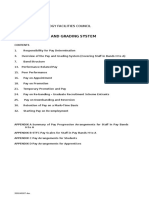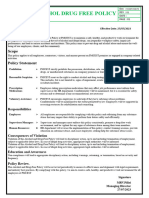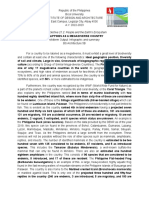Jsa For Pipe Fabrication Errection
Jsa For Pipe Fabrication Errection
Uploaded by
jithin shankarCopyright:
Available Formats
Jsa For Pipe Fabrication Errection
Jsa For Pipe Fabrication Errection
Uploaded by
jithin shankarOriginal Description:
Original Title
Copyright
Available Formats
Share this document
Did you find this document useful?
Is this content inappropriate?
Copyright:
Available Formats
Jsa For Pipe Fabrication Errection
Jsa For Pipe Fabrication Errection
Uploaded by
jithin shankarCopyright:
Available Formats
MEGHA ENGINEERING & INFRASTRUCTURES LTD
Job Safety Analysis
JSA Number: NEW REVISED Page No.1 of 8
Job being analysed: FOR PIPE FABRICATION / ERRECTION
Department/Section doing JSA: JSA
members:
Job Area / Location: Job MEIL, MECHANICAL
performers:
NORMAL APPROVALS: POSITION Name Designation Signature Date General Job Requirements/Common
PPE
JSA By: EHS
JITHIN a. HSE INDUCTION
SHANKAR b. HELMET
Job Supervisor: c. SAFETY SHOES
d. SAFETY GLASS
e. COVER ALLS
f. HAND GLOVES
Construction Manager
Safety Representative
SE&QFORM070 -- Rev 00 1 of 8 April 02
MEGHA ENGINEERING & INFRASTRUCTURES LTD
Job Safety Analysis
SEQUENCE OF BASIC JOB POTENTIAL HAZARDS ACTIONS (Safe working
STEPS practices/procedures/hazard
(Write risk levels-High/Medium/Low;
control/methods/PPE/action by)
(Number them with description, write frequency)
duration)
(1.0) Area preparation Slipping and tripping hazards Proper housekeeping of the area
Potential pinch, caught-in-
between, and crush points Potential pinch, caught-in-
between, and crush points
Back injury Training of personnel on proper
manual handling and lifting
techniques
(2.0) Material preparation- Slipping and tripping hazards Proper housekeeping of the area
Manual handling Potential pinch, caught-in-
between, and crush points Potential pinch, caught-in-
between, and crush points
Back injury Training of personnel on proper
manual handling and lifting
techniques
(2.01) Using crane Defective crane Crane must have valid 3rd party
inspection sticker and must have
passed with Client inspection.
Crane must have a documented
regular (i.e. monthly) maintenance
inspection.
Crane must have a documented
daily inspection before being used
SE&QFORM070 -- Rev 00 2 of 8 April 02
MEGHA ENGINEERING & INFRASTRUCTURES LTD
Job Safety Analysis
. Improper rigging technique A valid record of 3rd party
certificate of inspection of all
rigging equipment should be
available at all times
Defective rigging equipment
Incorrect identification of weight of An approved lifting permit must be
load available before any lifting activity
is done.
Incorrect identification of crane
lifting capacity Weight of load must be accurately
taken and should be reflected in
the lifting permit. Data on the
weight of the load can be taken
from shipping documents or any
technical specification documents.
A test lift should be conducted
before proceeding with the actual
lift to identify accurately the weight
of the load and to determine the
correctness of the rigging of the
load (i.e. the correct centre of
gravity)
All riggers and crane operators
must have a valid 3rd party
certificate and records must be
available at all times
Incompetent/non-qualified rigger A flagman should be available at
all times during any crane
movement.
SE&QFORM070 -- Rev 00 3 of 8 April 02
MEGHA ENGINEERING & INFRASTRUCTURES LTD
Job Safety Analysis
Congestion of area / Limited Crane operator must follow only
equipment movement one (1) signalman at all times.
Signalman must be clearly visible
to the operator.
Outrigger not fully extended For a mobile crane, outriggers
must be fully extended and must
rest on proper size outrigger mat
(i.e. 6" thick for 50 ton and below
and 8" thick for 60 tons and
above).
Area where crane lifting activity
Personnel working under
will be conducted should be clear
suspended load
and barricaded. It should also be
compacted and levelled off at
least 1% grade
No worker shall stay under
suspended load.
Two (2) tag lines must be used at
all times in order to control the
load properly.
No crane lifting shall be conducted
Bad weather condition during wind speeds higher than 20
miles/hour (32 km/hour or 9 m/s)
and no lift at night.
Overhead power lines Crane boom or load line must
maintain at least 20-feet distance
from any overhead power lines
with voltages up to 250,000 volts
and 25-feet distance for voltages
more than 250,000 volts.
Crane operator must follow only
one (1) signalman at all times.
SE&QFORM070 -- Rev 00 4 of 8 April 02
MEGHA ENGINEERING & INFRASTRUCTURES LTD
Job Safety Analysis
Signalman must be clearly visible
to the operator
(2.3) Material transportation Damage to existing and All vehicles shall be of adequate
surrounding facilities during capacity and of a design suitable
heavy/ light vehicle movement for work.
Only vehicles with permit shall be
allowed.
Trailer shall be fitted with side
restraints for containing long loads.
Avoid loads that extend beyond the
rear of vehicle.
Vehicles shall be fitted with audible
reverse alarm, controlled and
sighted by a banks man.
Drivers are not allowed to work
more than 12 hours shift period.
(3.0) Piping Fabrication Grinding disc break Grinding disc should be visually
Fabrication (cutting, positioning, fit inspected and suitable grinding
up, welding) wheel (rpm) shall be used.
Grinding machine guard shall not
be removed
Face shield shall be used during
grinding.
Ear drum damage, Hearing leak Ear plug should be used
Back fire wile gas cutting Flash back arrester should be
used
Accident with Hoist hook Visually inspect the hooks
Grounding
Object falling from stand Object should be properly secured
using slings or vise
SE&QFORM070 -- Rev 00 5 of 8 April 02
MEGHA ENGINEERING & INFRASTRUCTURES LTD
Job Safety Analysis
Electric Shock Electric equipment’s and cables
must be inspected and color
coded
ELCB (Earth leakage circuit
breaker) must connected to all
equipment’s
Material fall in Eyes Face shield and proper safety
goggles shall be used
Welding spatters Fire blanket should be used
(3.2) NDT (Non Destructive Testing) Exposure of radiation Radiation monitoring devices,
barricading, signboards
Use real-time radiation meter to
monitor activity level
(3.3) Heat Treatment Burns Proper PPE, and safe work area
preparation
Electrical Shock All equipment’s grounded, and
insulated
(4.0) Pipe Erection Crane toggle Steel plate/ wooden should be
used for outrigger pads
Struck by equipment Barricade the area and pictogram
/signboard where necessary
around the area covered with the
activity.
Scaffolding collapse Proper base plate and every
surface at ground
Wear recommended PPE and
Safety harness all time.
Proper work platform and access
means are to be secured
All scaffolding material should be
confirmed to standard.
SE&QFORM070 -- Rev 00 6 of 8 April 02
MEGHA ENGINEERING & INFRASTRUCTURES LTD
Job Safety Analysis
All scaffolding should have proper
scaff-tag and periodic checks to
be performed Suitable methods
for scaffolding erection shall be
done
Qualified and certified scaffolders
to erect and dismantle scaffolding.
Objects /Personnel falling from Close supervision at all time
temporary platform
Scaffolding have Toe-board
Scaffolding not to be used as
support for heavy loads
Check safe work load of chain
Chain block brake block, inspected and color coded
Belt sling /break Check the slings for damage
Check safe work load of slings
inspected and color coded
(5.0) Painting works Fumes inhalation /dermatitis Ensure proper paint mask
aerosols (cartridge mask are using will
spray painting) for manual painting
use dust mask &disposable
overalls rubber gloves
Ensure fire extinguisher are in
place
Environmental hazard land All empty paint tins must dispose
contaminations in designed area
Follow chemical MSDS Procedure
SE&QFORM070 -- Rev 00 7 of 8 April 02
MEGHA ENGINEERING & INFRASTRUCTURES LTD
Job Safety Analysis
Job rotation sufficient manpower
for the activity
Note:
1) If any of the tasks involves biological, physical or chemical hazards, then Industrial Hygienist must also sign this Form, against Any Other
Approving authority above.
2) If steps in a job are more than the space provided above, use a photocopy of this sheet to continue on the next page.
3) Details on safety (PPE, Hazards etc) and environmental requirements can be found in Safety & Environment Procedures available from the
Company Documents & Standards.
SE&QFORM070 -- Rev 00 8 of 8 April 02
You might also like
- JSA # 3 Column ErectionDocument6 pagesJSA # 3 Column ErectionRaghava Richhu100% (2)
- Jobs Safety Analysis (JSA)Document8 pagesJobs Safety Analysis (JSA)uttam mishra100% (1)
- Risk Assess JSA Bolt Tightening 012Document7 pagesRisk Assess JSA Bolt Tightening 012Abdeldjalil Ferhati100% (2)
- JSA Erection of Steel StructureDocument9 pagesJSA Erection of Steel StructureOvais Farooq100% (1)
- Jsa For Painting Operation: S.N o Scope of Activity Hazard Control Measures Requested byDocument3 pagesJsa For Painting Operation: S.N o Scope of Activity Hazard Control Measures Requested bywahyu nugroho100% (4)
- Job Safety Analysis Sheet: Electrical IsolationDocument1 pageJob Safety Analysis Sheet: Electrical IsolationLal Dhwoj67% (3)
- A111wan03105060eDocument158 pagesA111wan03105060edugi100% (3)
- Mig Welding Work JSA HSE ProfessionalsDocument2 pagesMig Welding Work JSA HSE ProfessionalsNoval Febri100% (1)
- JSA For Holiday Testing PDFDocument4 pagesJSA For Holiday Testing PDFMohammed Minhaj67% (3)
- Jsa Insulation WorkDocument19 pagesJsa Insulation WorkM M PRADHAN100% (3)
- Draft JSA Levelling & GradingDocument9 pagesDraft JSA Levelling & GradingAzeem Khan33% (3)
- Copy (4) of JSA For HDPE Liner Fusion Welding Includes Night WorksDocument7 pagesCopy (4) of JSA For HDPE Liner Fusion Welding Includes Night WorksMohammed Minhaj80% (5)
- JSA of Pipe Unloading.Document2 pagesJSA of Pipe Unloading.vijay kumar singh100% (2)
- JSA PaintingDocument1 pageJSA PaintingjonesNo ratings yet
- JSA Installation of PumpsDocument6 pagesJSA Installation of Pumpsyc safety100% (2)
- Jsa Pipe RackDocument8 pagesJsa Pipe RackRohit Thorat100% (2)
- Jsa For Arc WeldingDocument3 pagesJsa For Arc Weldingtnssbhaskar100% (9)
- JHA Arc WeldingDocument2 pagesJHA Arc WeldingechaNo ratings yet
- JHA - Handrails and GratingsDocument10 pagesJHA - Handrails and GratingsVidyesh Nair75% (4)
- 12-JSA Pipe Erection Work - Existing Pipe RackDocument4 pages12-JSA Pipe Erection Work - Existing Pipe RackSwaminathan ThayumanavanNo ratings yet
- Scaffolding JSA (General)Document5 pagesScaffolding JSA (General)Panchdev KumarNo ratings yet
- STFC Pay Grading System 3Document9 pagesSTFC Pay Grading System 3nishantNo ratings yet
- Jsa For Cutting, Grinding and Welding For GulfconDocument3 pagesJsa For Cutting, Grinding and Welding For GulfconOgunwa Emmanuel100% (1)
- PTA-JSA-001-Mobilization Deployment of Manpower & Beginning of The JobDocument3 pagesPTA-JSA-001-Mobilization Deployment of Manpower & Beginning of The JobSaiyad RiyazaliNo ratings yet
- JHA On Erection of Temporary ShedDocument15 pagesJHA On Erection of Temporary ShedM8Rskn6wcNo ratings yet
- Jsa For Manual Backfiling Usin Hand Roller CompactorDocument5 pagesJsa For Manual Backfiling Usin Hand Roller CompactorMohammed Minhaj100% (2)
- JSA Loading UnloadingDocument2 pagesJSA Loading UnloadingXtra Babe100% (2)
- JHA 08 On Erection of Roofing SheetsDocument3 pagesJHA 08 On Erection of Roofing SheetsAkhilesh Kumar100% (1)
- JSA For Hydrotesting PDFDocument6 pagesJSA For Hydrotesting PDFMohammed Minhaj100% (2)
- Jsa For Brick WorkDocument4 pagesJsa For Brick WorkSushil Kumar YadavNo ratings yet
- JSA - SK-erection & DismantlingDocument1 pageJSA - SK-erection & DismantlingEngr Tahir UL Haq100% (3)
- Jsa For RadiographyDocument3 pagesJsa For Radiographyjithin shankar100% (1)
- JSA For Coating and PaintingDocument7 pagesJSA For Coating and PaintingMuthu AlaguRajNo ratings yet
- Jsa PaintDocument2 pagesJsa PaintKhalid Naseem100% (1)
- Job Hazard Analysis - Granite Surface PlateDocument2 pagesJob Hazard Analysis - Granite Surface PlateRaziellia Nor SaafriNo ratings yet
- Jsa Compound Wall PaintingDocument2 pagesJsa Compound Wall PaintingEka100% (1)
- 02-070302 JSA For Relocation of Monkey Ladder For Construction of Phase-I Tranformer Bay in Brown Zone.Document4 pages02-070302 JSA For Relocation of Monkey Ladder For Construction of Phase-I Tranformer Bay in Brown Zone.Mohammed MinhajNo ratings yet
- JSA For Painting Works-Hazards ControlDocument4 pagesJSA For Painting Works-Hazards Controlkaleem0% (2)
- ARK JSA 0 Rev 00 Crane LiftingDocument6 pagesARK JSA 0 Rev 00 Crane LiftingREMYANo ratings yet
- 10.1 Jha Box-Up Spool or Valve 19.11.15Document6 pages10.1 Jha Box-Up Spool or Valve 19.11.15RahimNo ratings yet
- JSA For Fabrication WorksDocument11 pagesJSA For Fabrication Workssurendra behera100% (4)
- JSA For Blower Cyclone and Duct Installation - Revision 004Document8 pagesJSA For Blower Cyclone and Duct Installation - Revision 004WilsonNo ratings yet
- JSA-Crane Assembling (400 Ton)Document7 pagesJSA-Crane Assembling (400 Ton)ADARSH KRISHNANNo ratings yet
- 0 JsaDocument54 pages0 JsaRavi AmarlapudiNo ratings yet
- Thyssenkrupp Industrial Solutions (India) Job Safety AnalysisDocument4 pagesThyssenkrupp Industrial Solutions (India) Job Safety AnalysisNitesh KumarNo ratings yet
- JSA - Erection Boiler Install (SFILEDocument35 pagesJSA - Erection Boiler Install (SFILEHilman Nugraha100% (1)
- JSA Loading UnloadingDocument2 pagesJSA Loading Unloadingadnan amal yusfar100% (1)
- JSA For RCC, Foundation & Generator Installation (R-00)Document14 pagesJSA For RCC, Foundation & Generator Installation (R-00)Suju RajanNo ratings yet
- JSA For DuctDocument13 pagesJSA For DuctRakeshkasarlaNo ratings yet
- Ast Jsa - Piping FabricationDocument3 pagesAst Jsa - Piping Fabricationmd_rehan_2No ratings yet
- JSA - Structural Steel Fabrication and Installation WorksDocument3 pagesJSA - Structural Steel Fabrication and Installation Workssakthi venkat100% (1)
- JSA-02-trench Excavation by EquipmentDocument1 pageJSA-02-trench Excavation by Equipmentabou bakarNo ratings yet
- JS A Excavation Work For Electrical CableDocument3 pagesJS A Excavation Work For Electrical CableMohammed MinhajNo ratings yet
- Jsa For Steel Structure For Off PlotDocument13 pagesJsa For Steel Structure For Off PlotKhuda BukshNo ratings yet
- JSA For Chimney Works 17.09.2021Document2 pagesJSA For Chimney Works 17.09.2021Brenden PalanithangamNo ratings yet
- 4..pipe Spool Air Blowing & Cleaning JSA 04Document2 pages4..pipe Spool Air Blowing & Cleaning JSA 04Francis Vinoj100% (1)
- Job Safety Analysis (Rolling For MS Plates)Document1 pageJob Safety Analysis (Rolling For MS Plates)Muhammad Ali100% (2)
- Jsa For CPL MonorailDocument9 pagesJsa For CPL Monorailsanath adhikary0% (1)
- Jsa For Pipe Fabrication ErrectionDocument8 pagesJsa For Pipe Fabrication Errectiondeepakkumaryadav841441No ratings yet
- Overhauling of Centrifugal Pump HEI-LEPCL-HSE-JHA-003Document5 pagesOverhauling of Centrifugal Pump HEI-LEPCL-HSE-JHA-003Javid AaqibNo ratings yet
- Metering Skid ErectionDocument4 pagesMetering Skid ErectionNature BeautiesNo ratings yet
- HEI JHA Leakage RectificationDocument7 pagesHEI JHA Leakage RectificationJavid AaqibNo ratings yet
- Tra-05 For Heat ExchangersDocument3 pagesTra-05 For Heat Exchangersjithin shankarNo ratings yet
- Defensive Driving TrainingDocument14 pagesDefensive Driving Trainingjithin shankarNo ratings yet
- FMEA FMECA The WorkhorseDocument33 pagesFMEA FMECA The Workhorsejithin shankarNo ratings yet
- HSE WEEKLY REPORT MayDocument1 pageHSE WEEKLY REPORT Mayjithin shankarNo ratings yet
- Drinking Water Inspection Report 02Document1 pageDrinking Water Inspection Report 02jithin shankarNo ratings yet
- Hse Records and Statistics 2024Document1 pageHse Records and Statistics 2024jithin shankarNo ratings yet
- JournalDocument24 pagesJournaljithin shankarNo ratings yet
- Alcohol Drug PolicyDocument2 pagesAlcohol Drug Policyjithin shankarNo ratings yet
- Unit IG2 Tony BabuDocument14 pagesUnit IG2 Tony Babujithin shankar100% (5)
- Legal RegisterDocument3 pagesLegal Registerjithin shankar50% (2)
- Minuts of MeetingDocument2 pagesMinuts of Meetingjithin shankarNo ratings yet
- RTW Communication PlanDocument1 pageRTW Communication Planjithin shankarNo ratings yet
- Legal Register 01Document7 pagesLegal Register 01jithin shankarNo ratings yet
- Ehs Hse PlanDocument50 pagesEhs Hse Planjithin shankar100% (1)
- Road Safety StandardDocument2 pagesRoad Safety Standardjithin shankar100% (1)
- Organization ChartDocument1 pageOrganization Chartjithin shankarNo ratings yet
- Hazard Identification Risk AssessmentDocument5 pagesHazard Identification Risk Assessmentjithin shankarNo ratings yet
- Legal RegisterDocument3 pagesLegal Registerjithin shankarNo ratings yet
- TS June MonthDocument7 pagesTS June Monthjithin shankarNo ratings yet
- Organisation Chart Need To UpgradeDocument1 pageOrganisation Chart Need To Upgradejithin shankarNo ratings yet
- RVK CVDocument7 pagesRVK CVjithin shankarNo ratings yet
- Daily Man Power MallavaramDocument2 pagesDaily Man Power Mallavaramjithin shankarNo ratings yet
- Manpower For The Month: SEPT-2020: On Shore Terminal KG DWN 98/2 Development ProjectDocument2 pagesManpower For The Month: SEPT-2020: On Shore Terminal KG DWN 98/2 Development Projectjithin shankarNo ratings yet
- Updated Corporate Training SessionDocument4 pagesUpdated Corporate Training Sessionjithin shankarNo ratings yet
- SL No Date Permit No Permit Type Activity Permit Receiver Permit Under ReniwalDocument2 pagesSL No Date Permit No Permit Type Activity Permit Receiver Permit Under Reniwaljithin shankarNo ratings yet
- Activity Potential Hazard Safe Work Practice & Control MeasuresDocument1 pageActivity Potential Hazard Safe Work Practice & Control Measuresjithin shankarNo ratings yet
- S.No Date Type of Work Depth (MTS) Grade QTY Cum - Qty: Ogt, Ongc, MallavaramDocument2 pagesS.No Date Type of Work Depth (MTS) Grade QTY Cum - Qty: Ogt, Ongc, Mallavaramjithin shankarNo ratings yet
- NoDocument1 pageNojithin shankar100% (1)
- New Final Requirement-26.05.2017Document4 pagesNew Final Requirement-26.05.2017jithin shankarNo ratings yet
- Material Safety Data Sheet (MSDS) of Kh-75: 1. Identification of The Substance and of The CompanyDocument9 pagesMaterial Safety Data Sheet (MSDS) of Kh-75: 1. Identification of The Substance and of The Companyjithin shankarNo ratings yet
- O 0057Document2 pagesO 0057mikocorpusNo ratings yet
- Restrepo 2009Document8 pagesRestrepo 2009safaatNo ratings yet
- 300 00382 - Japanese Pharmacopeia Requirements For TOC Reference StandardsDocument2 pages300 00382 - Japanese Pharmacopeia Requirements For TOC Reference StandardsNguyen Minh NhutNo ratings yet
- Yusuffdm, Department of Management Studies, Indian Institute of Technology RoorkeeDocument5 pagesYusuffdm, Department of Management Studies, Indian Institute of Technology Roorkeeडॉ. सुधांशु जोशीNo ratings yet
- Masterseal 953 TdsDocument2 pagesMasterseal 953 TdspaulaNo ratings yet
- Philippines As A Megadiverse CountryDocument3 pagesPhilippines As A Megadiverse CountryMikaela Francesca RazonNo ratings yet
- Kenny-230718-Top 60+ Data Analyst Interview Questions and Answers For 2023Document39 pagesKenny-230718-Top 60+ Data Analyst Interview Questions and Answers For 2023vanjchaoNo ratings yet
- FinalIndividualPaperNilo B50Document3 pagesFinalIndividualPaperNilo B50kyleNo ratings yet
- Hydrology - SCS MethodDocument15 pagesHydrology - SCS MethodMr. Mark B.No ratings yet
- Individual or Joint Specimen Signature Card 07-31-2014Document1 pageIndividual or Joint Specimen Signature Card 07-31-2014Dialife Medical Equipment and SuppliesNo ratings yet
- Transformable Furniture (Presentation) Author Ibynta B TiewsohDocument48 pagesTransformable Furniture (Presentation) Author Ibynta B TiewsohadminNo ratings yet
- Roxas City 2019 ECONOMIC STRUCTUREDocument16 pagesRoxas City 2019 ECONOMIC STRUCTUREArnoldAlarconNo ratings yet
- Compact II Type 6600Document70 pagesCompact II Type 6600henry barbozaNo ratings yet
- Intellectual Property Law Course OutlineDocument5 pagesIntellectual Property Law Course OutlineortizluismichaelNo ratings yet
- DBMS Lab ManualDocument66 pagesDBMS Lab ManualMargie VilloriaNo ratings yet
- MOS Unit 05 zOSDocument45 pagesMOS Unit 05 zOSSEENIVASNo ratings yet
- Request For Inspection Civil Concrete PouringDocument2 pagesRequest For Inspection Civil Concrete PouringProject m7070% (1)
- Primary Side Power Switcher For Off-Line SMPS AP3968/69/70/70SDocument15 pagesPrimary Side Power Switcher For Off-Line SMPS AP3968/69/70/70SSandeep MohanNo ratings yet
- Kristian Tlangau - August 2014Document52 pagesKristian Tlangau - August 2014Mizoram Presbyterian Church SynodNo ratings yet
- Angix System3D CalibrationDocument21 pagesAngix System3D Calibrationservice iyadMedicalNo ratings yet
- Listening Comprehension: Time - Approximately 80 MinutesDocument11 pagesListening Comprehension: Time - Approximately 80 MinutesGAME OnlyNo ratings yet
- Introduction To Scratch ProgrammingDocument7 pagesIntroduction To Scratch Programmingodhiambojoseph281No ratings yet
- The Business Model Canvas QiscusDocument1 pageThe Business Model Canvas QiscusIsmail AmrullohNo ratings yet
- A.K. International - Price List 2011Document4 pagesA.K. International - Price List 2011pvrk_78No ratings yet
- CO NotesDocument22 pagesCO NotesSirisha VamsiNo ratings yet
- CV Muhamad Ari Abdul BassyrDocument2 pagesCV Muhamad Ari Abdul Bassyrari abdul bassyrNo ratings yet
- The Nursing ProcessDocument8 pagesThe Nursing ProcessSonia G. Ortiz100% (1)
- VJIM Proceedings 5th Intl. Conf April-2023 FinalPublicaitonFile v2FDocument306 pagesVJIM Proceedings 5th Intl. Conf April-2023 FinalPublicaitonFile v2Fsanalasravanthi123No ratings yet























































































































